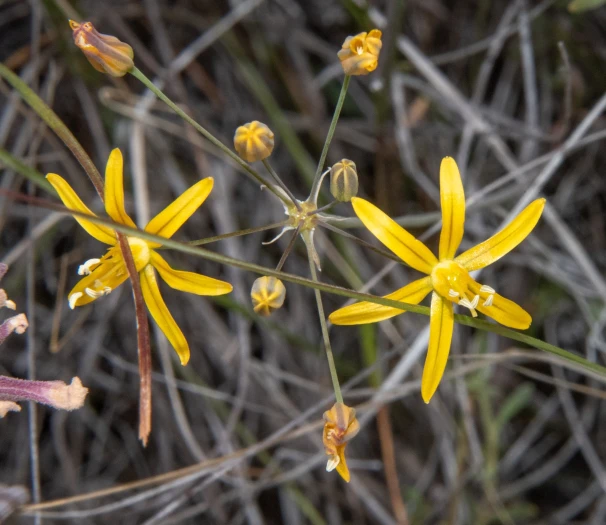Golden Stars
(Bloomeria aurea)
Golden Stars (Bloomeria aurea)
/
/

Don Loarie
CC BY 4.0
Image By:
Don Loarie
Recorded By:
Copyright:
CC BY 4.0
Copyright Notice:
Photo by: Don Loarie | License Type: CC BY 4.0 | License URL: http://creativecommons.org/licenses/by/4.0/ | Rights Holder: Don Loarie | Publisher: iNaturalist | Date Created: 2021-05-25T11:18:50-07:00 |
























Estimated Native Range
Climate Requirements for Windsor, Canada
| This Plant | Your Site | Plant Suitability for Your Location | ||
|---|---|---|---|---|
| • Precipitation | 10" - 30" | 35" | Your precipitation may be too high for this plant. | Too high |
| • High Temp. | 73°F - 97°F | 83°F | Your summer temperatures are normal for this plant. | Excellent |
| • Low Temp. | 27°F - 48°F | 18°F | Your winter temperatures may be too cold for this plant | Too cold |
This plant may not grow well at your location - your precipitation is too high.
Summary
Bloomeria aurea, commonly known as Golden Stars, is a perennial herb endemic to the grasslands and open woodlands of California. It typically grows to a height and width of about 1 foot. This species is characterized by its long, narrow, grass-like leaves and a striking inflorescence consisting of a bracted cluster of many flowers, resembling exploding fireworks. The flowers, which bloom from April to June, are a vibrant orange-yellow with bright green anthers, creating a showy display in late spring. Golden Stars are particularly noted for their large flower clusters that can contain around fifty blossoms each.
Golden Stars are valued for their bright, eye-catching flowers and are often used in wildflower gardens, rock gardens, and as border plants. They are also suitable for naturalized areas and meadow plantings. In cultivation, they require a warm position and well-drained rich sandy loam. During the growing season, moisture is essential, but once dormancy sets in and the foliage dies down, the bulbs should be kept dry until autumn growth resumes. Although they can tolerate temperatures down to between -5 and -10 °C, they are rarely seen in colder areas. Bloomeria aurea does best in full sun and is adaptable to low or medium water conditions, making it a drought-tolerant choice for water-wise gardens.CC BY-SA 4.0
Golden Stars are valued for their bright, eye-catching flowers and are often used in wildflower gardens, rock gardens, and as border plants. They are also suitable for naturalized areas and meadow plantings. In cultivation, they require a warm position and well-drained rich sandy loam. During the growing season, moisture is essential, but once dormancy sets in and the foliage dies down, the bulbs should be kept dry until autumn growth resumes. Although they can tolerate temperatures down to between -5 and -10 °C, they are rarely seen in colder areas. Bloomeria aurea does best in full sun and is adaptable to low or medium water conditions, making it a drought-tolerant choice for water-wise gardens.CC BY-SA 4.0
Plant Description
- Plant Type: Bulb
- Height: 1-1.3 feet
- Width: 0.769-1 feet
- Growth Rate: Moderate
- Flower Color: Yellow
- Flowering Season: Spring
- Leaf Retention: Deciduous
Growth Requirements
- Sun: Full Sun
- Water: Low, Medium
- Drainage: Fast
Common Uses
Edible*Disclaimer: Easyscape's listed plant edibility is for informational use. Always verify the safety and proper identification of any plant before consumption., Low Maintenance, Showy Flowers
Natural Habitat
Grasslands and open woodlands of California
Other Names
Common Names: Common Goldenstar, Common Goldenstar
Scientific Names: Bloomeria aurea, Bloomeria crocea var. aurea, Nothoscordum aureum
GBIF Accepted Name: Bloomeria crocea var. aurea (Kellogg) Ingram